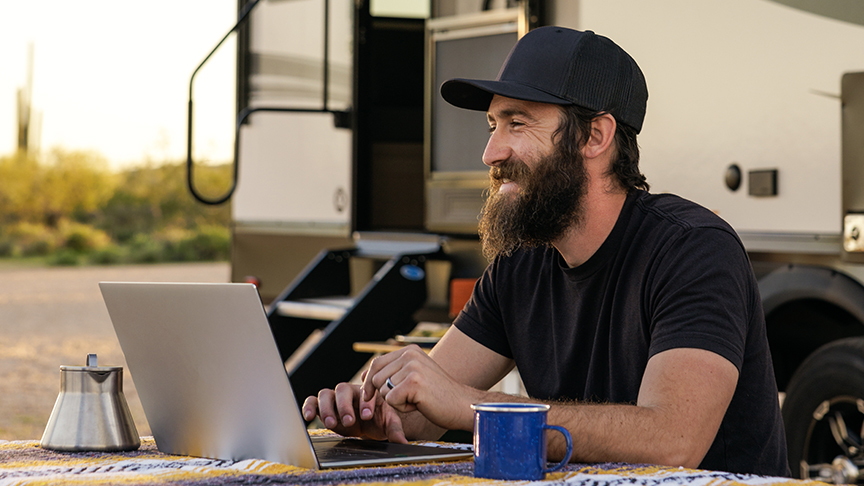
How to turn your van, RV, or trailer into a chiropractor-approved mobile office—without sacrificing connectivity.
Working from the road doesn’t have to mean hunching over a laptop in the back of a van. Maybe you’re managing deadlines from a Sprinter van in the desert. Or perhaps you’re leading Zoom calls from a lakeside RV. Either way, your workspace is important—your mobile office in your RV or van shapes how you feel and how productive you can be in your remote environment.
Often enough, nomads settle for a couch, folding chair, or bed as a desk. It seems fine at first, but over time, you will notice the wear on your body. "It may be common for someone to work with what they’ve got, which may be a couch or bed. Not having a proper work station can cause common postural misalignments over time," says Dr. Casey Genna, DC, a chiropractor based in Long Beach, CA. And no one wants that. We’ve gathered some straightforward upgrades you can make to help you work better on the road.
- Dr. Casey Genna, DC, a chiropractor who works with remote workers, contributed expertise to this article.
- This article was reviewed for accuracy by Amanda Capritto, TravlSync editor and full-time vanlifer.
Cell Signal Booster
Just learning how to work from an RV and you stumble on a campsite with no bars and no WiFi? When working in remote areas, you need a signal booster. These compact devices amplify weak cell signals and help you stay connected. TravlFi offers several options; they work with all major carriers, and can save you if you're serious about working off-grid.
Multi-Carrier Hotspot
Multi-carrier devices automatically switch between major cellular networks like US Cellular, Verizon, AT&T, and T-Mobile. That flexibility helps reduce connection gaps, especially for nomads working in varied locations. If your work depends on real-time calls or uploads, a stable connection is critical. Even short drops can interrupt meetings, pause uploads, or create added stress during busy days.
There are several mobile data options on the market that offer flexible plans and wide coverage. Look for devices that can switch networks without swapping SIM cards and consider data allowances that match your workload. Having a fallback plan for internet connectivity is one of the easiest ways to reduce stress on the road—and protect your workflow from random outages. And TravlFi offers a range of hotspot options, too.
Satellite Internet
Sometimes there's just no signal or WiFi of any kind. That’s where satellite internet like Starlink comes in. Yes, it typically costs more, and it might seem redundant to pay for both cellular internet and satellite internet. But when you're parked high in the Rockies or deep in the desert, it might be your only option. It can be used as a solid backup or as your primary connection.
It’s worth considering for folks who prefer boondocking in peace and quiet. If you're often posted up far from towns and cell towers, it's a useful fallback.
Rooftop Solar
Rooftop solar panels give you quiet, reliable power all day, so long as you’re parked in the sun. Plus, they will recharge your battery power while you’re working. Solar panels mean zero generator noise and no gas refills: All you’ll need is natural sunlight.
For mobile professionals, this allows for uninterrupted access to your devices during long meetings or work blocks. A consistent energy supply also supports routers, monitors, and backup drives that power your mobile setup.
Portable Solar Panel and Lithium Generator
If your rig’s parked under trees, rooftop solar won’t help. That’s where portable panels come in. Pair them with a lithium generator like the Patriot Power Generator 1200, set them in the sun, and run your gear in the shade.
Portable systems also make it easier to set up a workspace away from your rig. You can work outside at a picnic table, near a lake, or at a trailhead. Wherever your signal reaches, your office can follow.
Foldable Lap Desk
We’ll say it: The bed isn’t an office. But sometimes, it has to be. A foldable lap desk gives you a stable, level surface. This adjustable version on Amazon is light and easy to stash. Even with limited space, you can build a setup that supports long days of work. “Try not to hunch over if you’re using a lap desk. Propping the desk on pillows can help get your screen closer to eye level,” Genna notes.
Still, she thinks there are better long term options than a lap desk. “It may be comfy for a little, but it’ll do more harm to your body than good," says Genna. She recommends seeking out real chairs and workspaces when you can. "I’d recommend finding a coffee shop, library or somewhere with a table and good chair for support when possible. Don’t work from bed and be slouchy [if you can avoid it]."
180-Degree Swivel Seats
If you drive a van, your best office chair might already be in there. Swivel seats let you turn the cab into a lounge or a desk setup. Add a small table, and you’re set. Positioning is still important even with a table setup, according to Genna.
"Start from head to toe. Position your monitor at eye level, have your keyboard in a position that allows for straight wrists and relaxed elbows, adjust your chair to support your back, make sure knees are at 90 degrees and feet are comfortably planted on the ground," says Genna on creating the ideal mobile office in a van.
Hideaway Desk With Monitor Mount
Hideaway desks make small spaces work better as they fold away when not in use. Mount a monitor and tuck your station away after hours.
A mounted setup also encourages healthier habits. It helps keep your screen at the right height, which is especially important for long sessions. Plus, it’s a mental health perk to be forced to put your work away during off-hours.
Flip-Up Extra Counter Space
Need elbow room? Flip-up counters give you space when you need it and disappear when you don’t. Install one near your bench seat or galley, and use it for writing, cooking, or setting up a second monitor.
These RV accessories don’t take up valuable square footage, but they give you the flexibility to switch between tasks quickly.
Lagun Table With B-Pillar Mount
For those wanting a floating desk, a Lagun system mounts to your van's B-pillar. It then swivels and locks where you want it. Use it with a passenger swivel seat then pack it away when you’re done. The adjustable design works well in tight quarters and gives you room to shift throughout the day. It’s one of the easiest ways to turn existing space into something that feels intentional and ergonomic.
Bench Seats With Storage
A bench can do more than seat you. It can stash cables, routers, backup drives—anything. Dual-use storage helps you stay organized and mobile.
For anyone working in a tiny footprint, finding extra inches of storage means fewer stressors during the day. Not only do you gain a cleaner space, but you reduce decision fatigue when you can quickly grab what you need and get back to work.
Noise-Cancelling Headphones
Noise is part of life on the road (i.e., generators, neighbors at camp, etc.). Headphones with active noise canceling let you work through it. Look for something lightweight and foldable. Bonus points for long battery life. Even if you don’t mind ambient noise, headphones give you control over your environment, which helps reduce sensory fatigue.
Laptop Riser and Bluetooth Keyboard/Mouse
A laptop riser improves your posture. Add a Bluetooth keyboard and mouse if you can, so you can optimize ergonomics for your neck, shoulders, arms, and wrists. . (The Roost Stand is compact, light, and strong.)
"Screen height and keyboard placement are both easily overlooked," says Genna. "You can get creative and use books or a kitchen pot to prop your computer up to eye level; try to have your keyboard level with your hands and wrists.”
Genna emphasizes that even with a riser, breaks are necessary. "A 15- to 20-minute timed reminder would be a lovely way to acknowledge your body’s positioning and take a stretch and/or walk break," says Genna. These mini breaks keep discomfort from building. “Be proactive and not reactive. Don’t wait for pain to begin or get worse before correcting your work setup.”
FAQs
Is it possible to work full-time in a van?
Yes. With the right setup, many nomads work from the road every day. You need reliable internet; electricity, either from solar power or a fuel source like propane; and a good work station setup that encourages healthy posture.
What are some small home office ideas?
Try fold-down desks, or use multi-use furniture. A small table can be used for both work and meals. Try mounting a monitor on the wall, and incorporating swivel seats into your space.
What size battery is best for camper vans?
Most full-time workers go with 200 amp-hour lithium batteries or higher. This amount of power easily supports your office gear for a full day, and you can add solar to stay charged.
How can I avoid back and neck pain while working in a van?
Genna recommends starting with posture: “Focus on little tweaks to your posture. Even the smallest change can make the biggest difference. And don’t forget to drink your water!”
What are good stretches for digital nomads?
“A good chin tuck movement is great for your cervical spine and deep neck muscles,” says Genna. “Also a slight variation to the ‘serve the platter’ move… scapulas retract, elbows tuck into your sides. Hold for a few seconds and repeat.”
More Essential Reading for Busy Professionals On the Go:
- Back to School Tips for Virtual Students
- Best Digital Nomad Jobs in 2025 for RVers and Vanlifers
- Roadschooling this Year? Beginner-Friendly Tips for a Top-Tier Education on the Road
Learn more about how TravlFi can help upgrade your work-from-home set-up in your van or RV and keep you connected even in remote locations.

Article By: Lauren Keary
Lauren Keary’s passion for travel began during college when she sailed on Semester at Sea to 17 different countries. Since then, that number has grown to over 40. This passion for travel has also taken a foothold in her career, as she previously worked as a travel writer for BuzzFeed and the Evening Standard full-time, writing additional travel content for TripSavvy, Outside, and San Diego Magazine in her spare time. When she’s not writing about her adventures, you’ll probably catch her out on a hike with her dog Rusty, or looking for the best new coffee shop in town. But let’s be clear, she’s always going to be that friend in the friend group who’s catching flights (not feelings), so you’re much more likely to see her at 30,000 feet.
